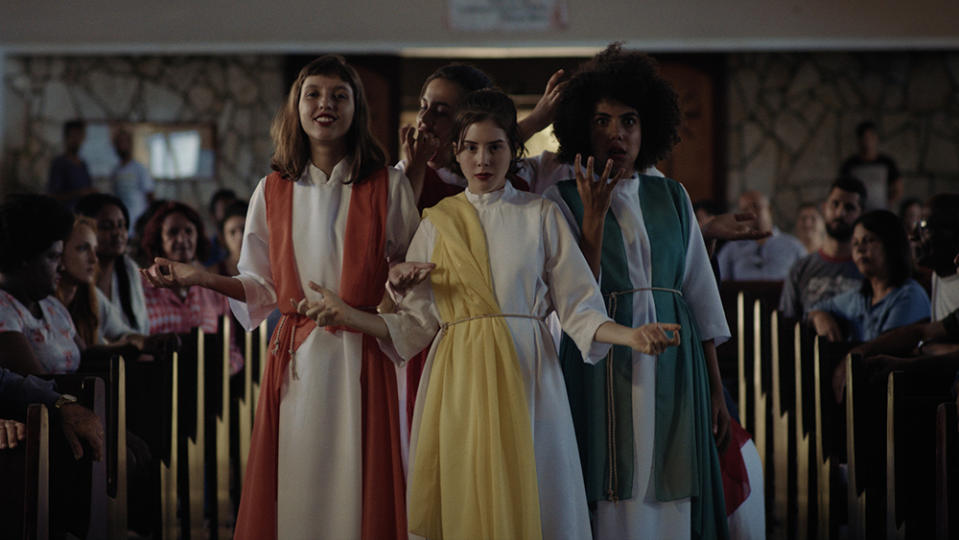Brazil’s Rafaela Camelo on Symbolism, Collaboration and Getting the Greenlight on Debut ‘Blood Of My Blood’

There are stepping stones to carving out a career as a filmmaker. It frequently involves them creating an idea for a short and perhaps finding collaborators willing to hustle. The first short could reach a small festival. It may get commended. Their next short film reaches a larger festival, with more cache. Bit by bit a reputation is built to a height where, if lucky, they get to develop their first feature.
One such filmmaker who has worked to reach this point is Brazil’s, Rafaela Camelo, selected by Variety as one of 10 Brazilian next gen talents.
More from Variety
Camelo’s “Blood Of My Blood,” is now greenlit to begin shooting later this year. Produced by Brazil’s Moveo Filmes and Apoteótica, Chile’s Pinda Producciones and Vertical Production inn France, it secured funding by winning the Audiovisual Fund for minority co-production of feature films from the Ministry of Culture, Arts and Heritage of Chile, and new director funding from Brazil’s Audiovisual Sectorial Fund (FSA) run by state film-TV agency Ancine, plus backing from the Support Fund DF Culture (FAC).
Her debut short, “A Arte de Andar pelas ruas de Brasília,” (“The Art of Walking Through the Streets”) was selected at the Festival Internacional del Nuevo Cine Latinoamericano in Havana, another short “O Misterio da Carne,” (“Desires of the Flesh”) was selected for the 2019 Sundance Film Festival and won a best film award at the Biarritz Latin American Festival.
Co-directed with fellow Brazilian talent Emanuel Lavor – whose screenplay for his feature project “The Jaguar,” won the Official Jury Prize at the 13th Brasil Cine Mundi international co-production meeting and now plays MAFF – her next work, “As Miçangas” (“The Beads”), screens today in Berlinale Shorts, the festival’s main competition for short-format films.
“Emanuel and I have been following each other’s work for several years and the partnership in “The Beads” came about as a result of mutual admiration. We share an obsessive approach to language that draws on many similar references. But we also complement and differentiate ourselves in many other places.”

In the film we join two sisters in a seemingly isolated country house. They collect water. They talk infrequently. The sisters are together because one needs support through an abortion. “I emphasize the subtle approach to the abortion theme, as it is a film that never mentions the word “abortion.” However, I see that the big question of the film is not the subtlety, but the accuracy of the question: “Who takes care of the woman who has an abortion?” Stalking the film literally and symbolically is a snake, prowling through the country house. This use of symbolism isn’t a first, and the Catholic constants of sin, the body, and ceremony emerge throughout previous work. One remarkable dance sequence in “Desires of the Flesh,” shows a group of teenage girls choreographed to mimic the eating of the forbidden fruit, prior to the priest washing their feet for Maundy.
Camelo was raised a catholic in the Planalto Central region of Brazil and carries the mysticism associated with the region, “It passes through my work not only as an inspiration but also in a certain way of seeing the world that considers the fabulous and the fantastic as part of reality. By also understanding myself as a Latin American filmmaker, I am directly affected by the social tensions arising from colonialism, poverty and the very specific way in which the church and the family interfere in the State.”
Her debut feature “Blood Of My Blood,” is said to be “a fantasy drama about two young girls who meet at a time when their bodies are in profound mutation,” Camelo continues. “Although the tone and the story of this film are completely different from the short films I have made, I want to evoke again the conflict between Christian religion and sexuality, by portraying a teenager, her anxieties and her desires. The story revolves around a metamorphosis of the body of the protagonist, who no longer recognizes herself, symbolizing the strangeness of puberty.”
The film will begin shooting later this year.
Best of Variety
Sign up for Variety’s Newsletter. For the latest news, follow us on Facebook, Twitter, and Instagram.

